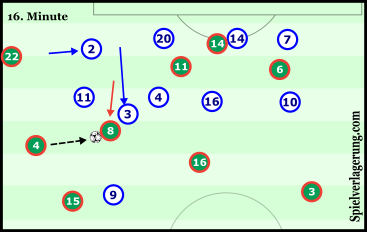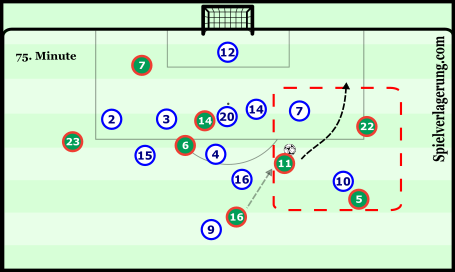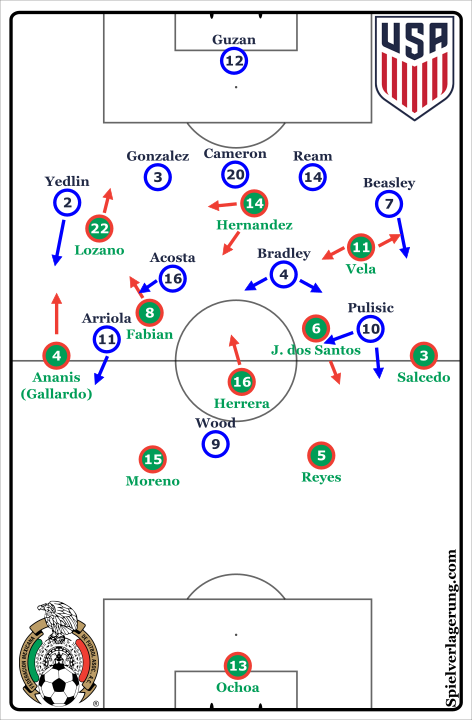USA leave the Azteca with a draw
The US continued their unbeaten streak under manager Bruce Arena on Sunday, after starting the last phase of CONCACAF World Cup Qualifying with two losses which led to the sacking of Jurgen Klinsmann. Even though Mexico remained at the top of The Hex after this match, the American team left with their heads held higher as they depart having drawn Mexico at the Estadio Azteca for just the third time in World Cup Qualifying history, doing so with a framework that deviated from their usual system of play.
Changes in US System, Adaptations to the Environment
The main talking point prior to the match was the change in system that the United States used to counter a Mexican team that has been strong and prolific under Juan Carlos Osorio. Rather than play the 4-4-2 diamond formation that Arena has used in his matches in charge thus far, he elected to switch to a 3-4-3 in order to increase central defensive stability against the talented front players of Mexico. A similar defensive system was used by Klinsmann in the return leg in Columbus in their 2-1 back in October.
Against the ball, wingbacks Yedlin and Beasley would drop in line with the central defenders while Arriola and Pulisic would do the same with the central midfielders. This created a 5-4-1 that was seen in a deep block throughout most of the match and frustrated Mexico, who handily dominated possession and often played in the visitor’s half.
Given the importance of this match to the US qualifying campaign, several preemptive measures were taken so that the US would be in the best possible physical condition in order to properly implement their strategy. The Estadio Azteca poses multiple environmental factors that impact the players physically, such as the altitude of just under 2,200 meters (7,200 feet) and the low air quality found in Mexico City. To prepare, they had their training camp and qualifying match against Trinidad and Tobago in Colorado, alongside a friendly played in Utah (where they played the 3 at the back formation in the second half) so that the players could get acclimated to competing at higher elevation. Whether or not this preparation had any effect is difficult to say from the outside.
Arena changed the playing personnel substantially between the qualifier on Thursday. The approach however was quite similar to what his predecessors have done at the Azteca, in that they conceded the bulk of possession to Mexico, hoping to score through counter attacks and set-pieces. On the other hand, Mexico played in the 4-3-3 system used throughout Osorio’s stint in charge, but opted to not name some of their usual starters to the squad such as Rafa Marquez, Andres Guardado, and Miguel Layun with the beginning of the Confederations Cup this coming week.
Mexico fall behind early, Aim to break through American defense
From the kickoff, the first actions of the game indicated that this match would be a physically aggressive affair, as the game was stopped three times in the beginning to attend to hurt players from both sides. Nevertheless, it was evident in the moments the ball was in the play that the United States was happy to concede possession to the home side.
After Michael Bradley scored a remarkable 40 yard chip to put the visitors in front inside five minutes, the US were able implement their defensive tactics with more of a cushion, knowing that there wasn’t pressure on them to score. Reflexively, this also led to the defensive structure moving closer and closer to their penalty area.
Initially organized in a medium block of sorts, the Mexican attackers struggled to find room due to the numbers advantage that the United States had in their typical spaces alongside the compactness between the first and second defensive banks. In response, the front players and some of the midfielders for Mexico would drop deeper to receive the ball since they could not be easily found higher up the pitch.
When this movement took place, one of the American center backs would step up with the striker, moving up as high as in line with the midfielders to follow their man. To ensure that the US were not leaving too much space to penetrate after this action, the remaining four members of the back five would pinch and decrease their horizontal distances.

As Fabian checks deeper, Omar Gonzalez steps up to prevent him from receiving with space to operate. In response, DeAndre Yedlin tucks inside to create a more compact shape.
This feedback-response relationship between the defensive unit was not always optimal, as Mexico created some of their most dangerous chances on the night from such miscommunications. In circumstances where the point of attack was changed and multiple players had dropped deeper, there were situations of uncertainty from the backline about who should be stepping up. Plus, a number of scenarios took place where the back four players did not pinch together following one of the central defenders stepping up to follow a player. Lastly, the defensive line as a whole was not always in line with each other, inviting penetration in behind for Javier Hernandez, one of the world’s best strikers when it comes to runs that are just barely onside. Lucky for the US, Hernandez hardly made the the movements like he did in the graphic below.

An example in which neither Cameron or Ream is sure which person should step onto Carlos Vela, combined with an uneven line and Hernandez gets his best chance of the evening.
On another note, American counter attacking efforts, in which Bobby Wood was often the first pass and Christian Pulisic was instrumental in execution, were solid. Many of these counter attacks led to set pieces and corner kicks, which have generally been a key hallmark of goals for the USMNT. In these circumstances, Omar Gonzalez was frequently the target, hoping to take advantage of his 1.95 meter frame. Some close chances came from these moments, but Mexico executed a great counter attack finished off by Carlos Vela following a USA corner to even the score halfway through the first half.
Osorio’s Adjustments
Unsatisfied with the way in his team were playing, Juan Carlos Osorio made two adjustments in his selection to try and improve the team’s ability to get into more advanced and dangerous positions. First, he swapped the positions of Carlos Salcedo and Diego Reyes, presumably with the goal of having improved circulation in the center of the park. Secondly, he made an early substitution when he subbed off left back Oswaldo Alanis for Jesus Gallardo, a midfielder by trade, done so that more attacks could take place down the left flank.
Hirving Lozano began to positioned more in the left half space, as him and Carlos Vela began to be positioned more in between the lines of the US. These adjustments when combined with the block of US defenders camped around the top of the penalty area gave promise that the hosts would take the lead, but they went into the first half with a goal apiece.
2nd Half Developments
The second half brought some slight adjustments from the US, mainly moving up the defensive line about 15 meters with the intent being that they would not always be retreated in their half. Since this tweak reduce the space in which Mexico could play and build up, they had to look for other solutions to get into the attacking third of the pitch since the compact defensive structure of the United States made building up through the center a difficult task.
The response from the Mexicans was to try and hit long passes in behind the back 5 of the United States. These balls were hit from deeper players, namely Herrera and Moreno, with the intent of stretching the opponents and creating more space for Vela and Lozano to play in. Unfortunately, this tactic did not have the desired effect for the home side, as the tall center back trio of the United States dealt with many of these aerial duels, alongside easily handling some of the ensuing corner kicks that followed when the US cleared the threat that came with these balls.
If this tactic was going to continue to be used, Mexico had more fitting players to better fit this style, such as Oribe Peralta and Raul Jimenez. The introduction of one of these players could’ve posed a more physical problem for the United States center backs, which in turn may have afforded more space for Hernandez or Vela to operate in. Instead, Mexico continued to struggle to create opportunities as the game continued on.
The final adjustment Osorio made to his team’s attacking approach was heavily wing-oriented, with a lot of emphasis on side-to-side ball circulation and getting players to attack the penalty area so that they can get on the end of crosses or cutbacks. Gallardo continued his role as the main source of width down the left flank and was often supported by substitute Javier Aquino, while Hirving Lozano was switched to the right side.

A near chance created as a result of the Reyes-Vela-Lozano grouping on the right wing late in the match.
The right side was now overloaded with the interactions between Vela, Lozano, and Reyes, and the bulk of Mexico’s late chances originated from these 3v2 situations. This adjustment was likely made with DaMarcus Beasley in mind, a USMNT veteran who spent most of his career as a winger but resurrected his national team career by converting to left back. With Vela’s goal coming from a duel with Beasley off a counter attack, perhaps Osorio thought that Beasley (accompanied by Pulisic) would not be able to handle the overload. Despite the multitude of chances that developed down the right flank up until the final whistle, Mexico were unable to get a second goal to take all three points.
Conclusion
None of Osorio’s adaptations to the US plan worked out for the Mexicans, which is bound to increase the unwarranted pressure on his job. Despite the negative coverage that Juan Carlos Osorio has received from the Mexican press, he has still amassed an impressive reign in his time in charge as Mexico’s manager. With only two losses from 24 games, his Mexico side, bolstered now by a close to full strength team, is one to watch for in the upcoming Confederations Cup. They remain in a position to comfortably qualify for the World Cup after this match.
As for the United States, this result will be important for their qualification hopes. In the grand scheme of things, their position hardly was in danger entering the new year, as getting 16 points (the average number of the 3rd place team in the Hex the past 3 cycles) in 8 matches, having played the two toughest opponents already once, is very achievable given the American ranking in CONCACAF. Nevertheless, this result is still important. Meanwhile, the jury is still out about whether Arena’s National Team can go toe to toe with the top international sides in the world.



1 Kommentar Alle anzeigen
IEPerez94 June 13, 2017 um 8:40 am
I wont say im completely convinced in the work of Osorio with el tri, but i do recognise that he has brought some important aspects to the national side, that had been neglected by previous coaches. Overloads, for example, which do tend to be overlooked, as well as the use of the half spaces. Very little attention is brought to these aspects in our football. The other thing, is his tactical flexibilty, always taking the rival into consideration, which seems almost taboo in our football. There’s still some asoects that i would like to see improve, like the selection of certsin individuals during certain cirumstances, like the example you mentioned with oribe or jimenez. Also in this game, bringing pineda was of no use. Got to give it to him though, bringing gallardo really helped mexico control the game. Really excited to see him in the confed. Hopefully he’ll be able to bring out the best from the team and finally give mexico a decent international participation after so many years